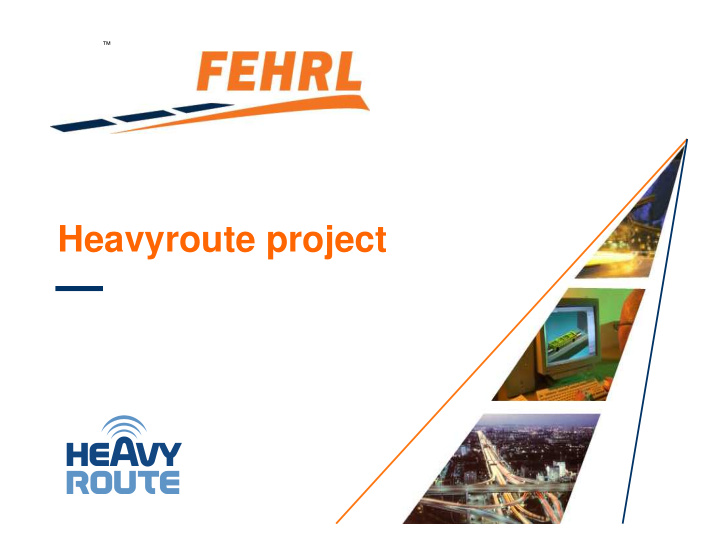



™ Heavyroute project
Heavyroute project • Three year project (2006-2009) • Co-funded under the Sixth Framework Programme of the European Commission • DG Research (Sustainable Surface Transport Unit) • Specific Targeted Research Project • Eight project partners
What the EC asked for….. Technical specification (Call 3B, 9/2005) The research will focus on increasing the capacity of existing and new transport infrastructure by maximising safety and well being of drivers , passengers, crew and pedestrians. The aim will be the development of strategies, systems and technologies to attain optimal operational performance of vehicles/vessels and their supporting infrastructure, seeking to halve the number of transport fatalities by 2010 and increasing capacity by 15%. Technological innovation will largely rely on computer-based decision support tools, information services on the condition of transport routes (e.g. road holding , sea state or traffic congestion) and vehicle/vessel operational responsiveness .
What the EC asked for….. Technical specification As a contribution to a possible future large-scale integration and validation platform across modes for the realisation of the intelligent transport vehicle and infrastructure of the future, technology will concentrate on intelligent vehicles/infrastructure interactions and advanced management and guidance systems . This might include satellite navigation systems capable of stabilising vehicle trajectory, with respect to lateral and longitudinal displacement, and will regulate vehicle speed and separation with high accuracy and reliability.
What the EC asked for….. More general issues • Building the European Research Area by strengthening links within, and between, appropriate organisations. • Heavyroute is the first joint FEHRL-ERTICO project • Influenced by current EC priorities concerning CO 2 reduction and connecting with public. • Selling the value of Europe • EC priorities on gender issues
Intelligent Route Guidance for Heavy Traffic • A major step towards implementing the concept of “Intelligent Highways” on a European scale: • Provide an efficient guidance using traffic + infrastructure data: • Weather conditions (Skid resistance, Fog, rain • Actual road status (bearing capacity, geometry etc) • Traffic status (flow, journey times, accidents, road work) • Vehicle (axle loads, speed limit, type of goods)
Information for trucks – not cars!
The future? More and more Longer & heavier
Main objectives • Improve capacity (reduced costs) for commercial transport (coaches, HGVs) due to more efficient transport routes • Provide cost savings for road authorities due to less road maintenance, better use of roads, + differentiated pricing possibilities • Decreased pollution (noise, emissions etc) due to optimal route choice suited to Heavy vehicles • Increased safety & security due to efficient traffic management using trans national road data base
Stakeholders and possible benefits Road authorities, society • Reduced infrastructure maintenance costs, pollution and accidents Transport/ Logistic companies • Reduced fuel costs, shortened journey times, meets environmental demands, better working conditions Service providers • Add-on’s to existing services, increases demand for regional services (weather info etc) Heavy vehicle/ coach manufacturer • Increased product performance with new navigation platforms and adopted driver HMI
This workshop • Further develop user requirements • Building on questionnaire • Report on User requirements • Broad range of invited stakeholders • Please contribute freely………..
Recommend
More recommend